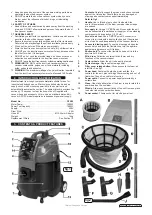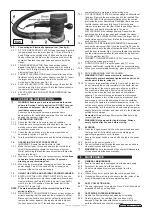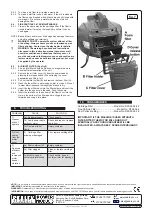
1.2
WORKSHOP/ENVIRONMENTAL SAFETY
WARNING!
Ensure that all relevant Health and Safety, Local
Authority, Control of Substances Hazardous to Health
(COSHH) and General Workshop Practice
Regulations are
strictly adhered to when using this equipment.
Ensure there are no flammable or combustible materials near
the work area.
Locate dust free vacuum system in a suitable work area.
Keep area clean and tidy and free from unrelated materials.
Ensure there is adequate lighting.
DO NOT get the dust free vacuum system wet or use in
damp or wet locations.
Dispose of waste products in accordance with local authority
regulations.
1.3
MAINTENANCE SAFETY
WARNING!
Disconnect dust free vacuum system from mains
power and air supply before changing accessories, servicing
or performing maintenance.
Maintain the
dust free vacuum system in good condition (use
an authorised service agent).
Replace or repair damaged parts.
Use recommended parts
only. Unauthorised parts may be dangerous and will
invalidate the warranty.
1.4
AIR SAFETY
WARNING!
Ensure correct air pressure is used, maintained,
and not exceeded for the sander attachment.
The air supply should be adequate for a
minimum
of 10.6cfm
free air delivery to the sanding tool. There should be a
minimum
of 13cfm free air delivered to the air inlet of the
dust free vacuum system. We recommend the use of a 3HP
(or more) compressor.
Air supply must be delivered through a 3/8” internal diameter
air hose. If you use a 5/16” internal diameter the
performance of the tool may suffer.
Keep air hose away from heat, oil and sharp edges. Check
air hose for wear before each use, and ensure that all
connections are secure.
Before each use check attached tool for condition. If worn or
damaged replace immediately.
WARNING!
Ensure you turn off the air supply before
detaching the air hose from the vacuum system.
When not in use ensure that the air supply is turned off.
1.5
OPERATOR SAFETY
WARNING!
Always wear appropriate approved eye, face,
mask, ear defenders, or protective clothing according to task
being undertaken.
1. SAFETY INSTRUCTIONS
INsTRuCTIONs fOR:
COMBINATION dusT
free/WeT & drY VACuuM sYsTeM AIr/
eLeCTrIC 55LTr
MODEL NO:
dFS55
Thank you for purchasing a sealey product. Manufactured to a high standard this product will, if used according to these instructions and
properly maintained, give you years of trouble free performance.
IMPORTANT
:
PLEASE REAd THESE INSTRUCTIONS CAREFULLY. NOTE THE SAFE OPERATIONAL REQUIREMENTS, WARNINGS, ANd
CAUTIONS. USE THIS PROdUCT CORRECTLY, ANd WITH CARE FOR THE PURPOSE FOR WHICH IT IS INTENdEd. FAILURE TO dO SO
MAY CAUSE dAMAGE ANd/OR PERSONAL INJURY ANd WILL INVALIdATE THE WARRANTY.
1.1. ELECTRICAL SAFETY.
WARNING! It is the user’s
responsibility to read, understand and comply with the
following:
You must check all electrical equipment and appliances to
ensure they are safe before using. You must inspect power
supply leads, plugs and all electrical connections for wear and
damage. You must ensure the risk of electric shock is
minimised by the installation of appropriate safety devices. An
RCCB (Residual Current Circuit Breaker) should be
incorporated in the main distribution board. We also
recommend that an RCD (Residual Current Device) is used
with all electrical products. It is particularly important to use an
RCD with portable products that are plugged into an electrical
supply not protected by an RCCB. If in doubt consult a
qualified electrician. You may obtain a Residual Current
Device by contacting your sealey dealer. You must also read
and understand the following instructions concerning electrical
safety.
1.1.1.
The Electricity At Work Act 1989
requires all portable
electrical appliances, if used on business premises, to be
tested by a qualified electrician, using a Portable Appliance
Tester (PAT), at least once a year.
1.1.2. The
Health & Safety at Work Act 1974
makes owners of
electrical appliances responsible for the safe condition of the
appliance and the safety of the appliance operator.
If in any
doubt about electrical safety, contact a qualified electrician.
1.1.3. Ensure the insulation on all cables and the product itself is
safe before connecting to the mains power supply. see 1.1.1.
& 1.1.2. above and use a Portable Appliance Tester (PAT).
1.1.4. Ensure that cables are always protected against short circuit and
overload.
1.1.5. Regularly inspect power supply, leads, plugs for wear and
damage and all electrical connections to ensure that none is
loose.
1.1.6.
Important:
Ensure the voltage marked on the product is the
same as the electrical power supply to be used, and check
that plugs are fitted with the correct capacity fuse. A 13 amp
plug may require a fuse smaller than 13 amps for certain
products, see fuse rating above.
1.1.7. DO NOT pull or carry the appliance by its power supply lead.
1.1.8. DO NOT pull power plug from socket by the power cable.
1.1.9. DO NOT use worn or damaged leads, plugs or connections.
Immediately replace or have repaired by a qualified electrician.
A u.K. 3 pin plug with AsTA/Bs approval is fitted. In case of
damage, cut off and fit a new plug according to the following
instructions (discard old plug safely). (uK only - see
diagram above).
Ensure the unit is correctly earthed via a three-pin plug.
a) Connect the green/yellow earth wire to the earth
terminal ‘E’.
b) Connect the brown live wire to live terminal ‘L’.
c) Connect the blue neutral wire to the neutral terminal ‘N’.
d) After wiring, check that there are no bare wires, that all
wires have been correctly connected, that the cable outer
insulation extends beyond the cable restraint and that the
restraint is tight.
Double insulated products are fitted with live (BROWN) and
neutral (BLuE) wires only. Double insulated products are
always marked with this symbol.
To re-wire, connect the
brown and blue wires as indicated above. DO NOT
connect the brown or blue to the earth terminal.
1.1.10. some products require more than a 13 amp electrical supply.
In such a case, NO plug will be fitted.
You must
contact
a qualified electrician to ensure a 30 amp fused supply is
available. We recommend you discuss the installation of an
industrial round pin
plug and socket with
your electrician.
1.1.11.
Cable extension
reels.
When a cable
extension reel is used
it should be fully
unwound before
connection. A cable
reel with an RCD
fitted is recommended
since any product
which is plugged into
the cable reel will be
protected. The section
of the cores of the
cable is important and should be at least 1.5mm², but to be
absolutely sure that the capacity of the cable reel is suitable
for this product and for others that may be used in the other
output sockets, we recommend the use of 2.5mm² section
cable.
FUSE RATING
THIs PRODuCT MusT BE fITTED WITH A
13 AMP FUSE
Yellow & Green
Earth Wire
Cable
Restraint
Brown
Live
Wire
Blue
Neutral
Wire
Original Language Version
Dfs55 Issue: 2 - 17/02/10























